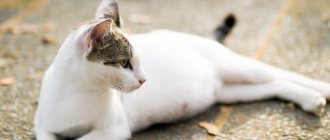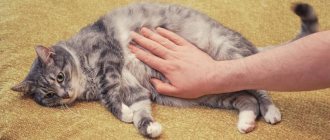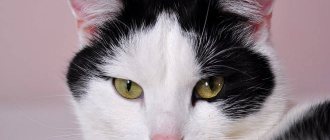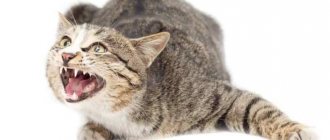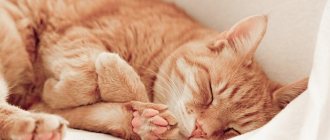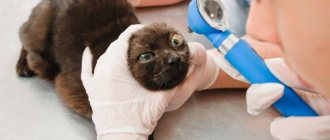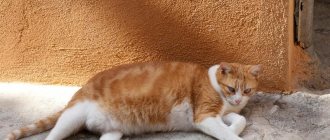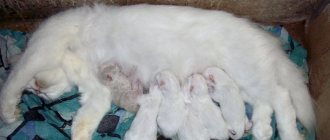Changes in the color of the skin, mucous membranes and eye membranes indicate the development of such a symptom of damage to the body as jaundice in a cat. Diseases develop as a result of internal pathological processes, external toxic effects or violations of the regime of keeping and feeding the animal. This condition requires immediate attention to a veterinarian. The disease is not contagious to humans and cannot be transmitted from animals.
Causes
The bile pigment bilirubin is a waste product of the breakdown of hemoglobin. Its high concentration in the blood gives the corresponding color to the mucous membranes and open depigmented areas of the skin. According to the causes of occurrence, jaundice is divided into the following types:
- hemolytic (suprahepatic);
- hepatic (parenchymal);
- mechanical (subhepatic).
Jaundice of the mucous membranes of the mouth
Hemolytic jaundice
The reason for the increase in the concentration of bile pigment is hemolysis, that is, increased breakdown of red blood cells. Bilirubin is toxic, the body tries to get rid of it in all ways, through the mucous membranes and skin. This situation is typical for infectious diseases or poisoning. The following pathologies are contagious causes of the development of suprahepatic jaundice:
- viral infections;
- dirofilariasis – helminthic infestation;
- hemobartonellosis is a disease caused by rickettsiae that parasitize red blood cells;
- leptospirosis.
Hemolysis can be caused by insect bites or by eating rodents poisoned with anticoagulants.
Hepatic jaundice
Organ damage occurs under the influence of the following harmful factors:
- infectious diseases;
- side effects of medications;
- hepatitis;
- liver failure;
- cirrhosis;
- lipidosis;
- malignant neoplasms.
Obstructive jaundice
Caused primarily by blockage of the bile ducts for the following reasons:
- inflammation of the bladder;
- compression of the ducts of the hypertrophied pancreas;
- cholelithiasis.
Danger of disease
Worsening the animal’s condition also leads to yellowing of the mucous membranes.
The development of jaundice in a cat threatens the health and vitality of the animal. Veterinarians warn that untimely treatment, incorrectly selected therapy, or insufficiently careful implementation of medical prescriptions lead to severe liver damage and the inability of the pet’s body to remove waste products. As a result of accumulation, bilirubin poisons the blood; the cat’s skin, mucous membranes, mouth and tongue become yellow. If the eyes and nose turn yellow, the auricle turns yellow, gradual death of organs and death occurs.
Diagnostics
Blood tests for different types of jaundice show different results. The detection of young forms of red blood cells in the blood, an increase or decrease in the concentration of bilirubin is of diagnostic importance. Testing the activity of alkaline phosphatase and liver transaminases is informative. The content of pigments - stercobilin, urobilinogen, bilirubin - is determined in urine and feces. If necessary, the veterinarian prescribes ultrasound and radiographic examinations.
With hepatitis, the cat is exhausted
Types of jaundice in cats
- Mechanical - occurs as a result of blockage of the liver ducts, gall bladder or excretory ducts by a foreign body, parasites or tumors. Due to a violation of the outflow, bile does not enter the intestines, being absorbed directly into the blood.
- Parenchymal - occurs when the functioning of liver cells is disrupted, because of this, its work is disrupted and bilirubin is released into the blood.
- Hemolytic - occurs with excessive destruction of red blood cells, which causes increased formation of bilirubin outside the liver.
What is bilirubin?
This is a bile pigment, which is formed after the breakdown of proteins, and contains the iron-containing fraction of heme - cytochrome cells, myoglobin and hemoglobin. As a result of breakdown, it is normally utilized through the liver, from there it enters the intestines along with bile and is excreted along with feces. Filtration also occurs in the kidneys.
There are two types of bilirubin - direct and indirect. Indirect is formed precisely at the moment of breakdown of red blood cells and is toxic to the body. Direct is formed after neutralization of unbound in the liver. It is slightly toxic and has the property of soluble in water.
Treatment
Treatment strategy:
- eliminating the cause of the disease;
- symptomatic therapy;
- caring for chronically ill animals.
Eliminating the cause of the disease
Depending on the pathogen, antibiotic therapy is prescribed. The sensitivity of mycoplasmas and leptospira to antibiotics is not the same. Rickettsia are susceptible to chloramphenicol and tetracycline, bacteria at the initial stage are susceptible to penicillin antimicrobial agents. Treatment is long-term and requires changing antibiotics. In parallel, maintenance therapy is carried out, as well as immunocorrection with Gamavit, Immunofan or Roncoleukin.
Ronkoleikin
If the main cause is dirofilariasis, pyrantel or other anthelmintics are used. Viral diseases are treated according to developed programs.
In all cases, it is necessary to eliminate the symptoms of anemia. This is achieved by switching to premium food. Sea fish is removed from the diet, some types of which contain substances that block the absorption of iron. They use drugs containing cyanocobalamin and folic acid, which are necessary for the synthesis of hemoglobin. Some diseases require surgery.
Symptomatic therapy
Used when acute phenomena are stopped. Hepatoprotectors are used - Sirepar or Essentiale Forte, but the main method of treatment is diet therapy. Cats need gentle nutrition, which cannot be reproduced at home from natural products. Therefore, premium medicinal food is used for cats with liver disease.
Therapeutic food for cats with liver disease
For liver diseases, many drugs that place additional stress on the organ are contraindicated. If leptospirosis is diagnosed, then you should choose medicated food for cats with kidney disease.
Caring for chronically ill animals
The owner of a cat who has had jaundice must come to terms with the fact that the pet will need lifelong care. The disease disables a significant part of the liver. Treats should be avoided in favor of diet food. You cannot give painkillers familiar to humans on your own; they can kill your pet. An alarming symptom is lightening of feces and darkening of urine.
Clinical signs
Here are the main symptoms that may indicate incipient jaundice or other liver problems:
- Vomit.
- Diarrhea.
- Lethargy (coma).
- Fever of intermittent and constant type.
- Abdominal pain.
- Loss of appetite (anorexia).
- Pallor.
- All visible mucous membranes become yellowish.
- Urine looks like orange juice, and feces, on the contrary, take on the appearance of whitish plasticine.
- Urination becomes more frequent and the total daily volume of urine increases.
- Increased thirst (polydipsia).
- In advanced cases, serious mental disorders of the animal are noted: the cat may become inadequate, aggressive or completely apathetic.
- Weight loss.
- Internal bleeding (especially in cats with advanced liver disease).
Prevention
Jaundice is a symptom of a large number of diseases. It is not those cats that are infected with something that get sick, but animals with reduced immune defenses. Animals that eat nutritious food and live in a comfortable environment are less likely to get sick. To maintain immune defenses, cats are regularly dewormed, skin parasite free, and vaccinated.
Jaundice is a symptom of infectious and non-communicable diseases. Concomitant factors for the occurrence of the disease are unbalanced feeding and unsatisfactory maintenance. Leptospirosis is considered a common disease for humans and cats.
We invite you to join our Zen channel and group on VKontakte or Odnoklassniki, where new articles for pet owners are published.
Similar articles:
- If your cat has food allergies
- Ringworm Caution: What Pet Owners Need to Know
- Why are cats overweight?
Diagnosis
The veterinarian should interview you in detail and then take any necessary tests from your animal. Routine laboratory tests include the following: complete blood count, including biochemistry, urine test. In some cases, it is necessary to resort to liver biopsy. These tests will provide very valuable information for making an initial diagnosis. Checking blood biochemistry will show the state of the hematopoietic system and other parameters, allow you to diagnose severe anemia, blood parasitic infections and promptly detect clotting disorders. In addition, it is incredibly valuable in that it allows us to identify pathologies associated with the synthesis of liver enzymes.
Of course, blood testing is not the only valuable method. X-ray studies will help determine the structure and size of the liver or spleen. The veterinarian will see tumors, an enlarged spleen, and in some cases, the presence of foreign bodies. Ultrasound examination is even more important, as it allows us to evaluate the structure of the liver in detail: this is how parenchymal jaundice in cats differs from bile duct obstruction. The same method makes it possible to differentiate a tumor from a cyst of parasitic etiology.
How long does it take to treat hepatitis, what are the possible complications?
Hepatitis, as a rule, does not go away quickly. With timely treatment, when treatment begins in the early stages of the disease, improvement occurs after 7–14 days. However, the duration of therapy depends not only on timely measures taken, but also on the pet’s immunity, its age, and the type of pathogen. You cannot treat animals for jaundice on your own. Prescriptions are made only by a veterinarian, based on test results and the condition of the cat.
The risk of developing complications with hepatitis is very high, which is why it is so important to make a correct diagnosis in time. Impaired liver function can lead to the following complications:
- lipidosis – replacement of structural liver cells with adipose tissue due to the fact that the pet does not eat for a long time;
- encephalopathy – brain damage as a result of prolonged intoxication of the body with metabolic products;
- ascites (dropsy) – effusion of lymphatic fluid into the abdominal cavity;
- Cirrhosis is an irreversible pathology in which liver cells are gradually replaced by fibrous ones.
Symptomatic diet and procedures
Most often, once the diagnosis is made, the veterinarian can give an approximate prognosis for the cat’s recovery.
In order for the animal to recover as quickly as possible, it is important to follow the doctor’s recommendations and adhere to the following rules:
- Administer medications in strictly prescribed dosages, without increasing or decreasing them. To ensure that the medicine gets into the cat’s body, experts recommend pouring it, dissolved in water, into the animal’s mouth using a syringe without a needle.
- It is necessary to strictly follow the diet. The diet should be balanced in terms of the ratio of proteins and carbohydrates, but it should not contain a lot of fat. You can buy food that is designed specifically for cats with liver failure. If this is not possible, then a veterinarian should advise the breeder on the menu.
- Offer your cat water to drink. It should be clean, cooled to room temperature.
- Cats with symptoms of jaundice and yellowing of the eyes should not be self-medicated. Such an “oversight” can kill the animal, since almost all drugs are toxic to the liver, which at this moment needs treatment.
- If the condition worsens (especially if the urine becomes dark and the feces become discolored, or streaks of blood appear in the animal’s feces), the cat should be urgently taken to the veterinarian. The gallbladder may have ruptured.
- The cat needs to be provided with peace; you cannot pick it up unless it comes running itself. We need to arrange a place for her to lie down.
- If the cat recovers, then you cannot deviate from the diet and return the animal to its previous lifestyle. The cat's liver is still very weakened, it needs to recover.
- If anemia occurs, it is recommended to switch your cat to food with a high iron content.
- Support the animal's immunity. To do this, you need to introduce vitamins and minerals into your diet. But this should be done only after consultation with a specialist.
A cat's yellowed eyes are a reason to contact a veterinarian, but not a reason to panic. In most cases, timely contact with specialists prevents the development of irreversible complications, and the animal can be cured. Veterinarians recommend that all breeders monitor their cats and undergo routine examinations.

